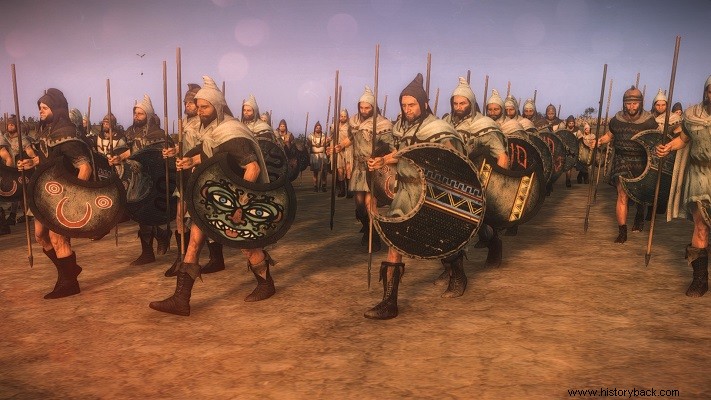
The peltasts, in contrast to the psilouis, are conventionally characterized as light infantry, simply because they were lighter than the hoplites. In reality the peltasts were multi-role infantry, an intermediate type between heavy infantry and acrobats. Peltastes were the main type of infantry in the Thracian and early Macedonian Greek armies.
They were equipped with a number of javelins, a light shield and a sword. The shield of the Thracian peltasts bore an ellipse on its right side and resembled that of the Mycenaean warriors depicted on the Warriors vase. From that peculiar shield of theirs, the pelti , the peltastes also received their name. Some also wore helmets. The peltastes were arranged in a loose order, but denser than the equivalent of the psilis, at a depth no greater than 8 yokes.
Due to their light armament and their formation they were fast and flexible in any type of terrain. But they were in difficult terrain where they were literally invincible. Their denser ranks gave them a clear advantage over smalls, and their speed and agility made them particularly dangerous opponents for hoplites.
Like the peltasts, the peltasts trembled only at the charge of cavalry against them, on smooth ground. From the heavy infantry they had no reason to fear, because due to speed, they could engage or disengage with it as they pleased.
Inspired by the Macedonian and Thracian peltasts and the powerful southern Greek cities gradually began to develop peltast divisions. They usually leased parts of Thrace which, after the end of the operations, returned to Thrace. Later, however, they formed peltast units themselves, from their own citizens who normally joined the permanent forces of each city.
Sparta took longer than other cities to develop peltast corps and during the Peloponnesian War it relied on mercenary northern Helladic peltast corps. Even in the Peloponnesian War, however, the number of peltasts who were involved in their operations, overall, was very small compared to the number of hoplites or psils and roughly proportional to the number of horsemen.
In contrast to the psilus, which were positioned in front of the phalanx and functioned as "light artillery", the peltasts acted mainly deployed on the sides of the phalanx, as agile flank guards. Many times they acted in close cooperation with the cavalry. The 1,000 or so peltasts of the Myrian army acted as a bodyguard in the famous battle of Kounaxa in Babylon in 401 BC
There the Greek peltasts covered the right flank of the Greek phalanx, positioned between the hoplites and the Euphrates river. In this position and having exhausted their javelins, the Greek peltasts received the advance of the Persian cavalry, which, despite the smooth terrain, they faced with exemplary composure, only with swords, victorious.
However, the role of the peltasts was to be upgraded even more, according to tradition, by the Athenian general Iphicrates. He armed the peltasts by providing them with a spear. In this way the peltasts became truly capable of fighting alongside the hoplites almost as their equals.
The reforms attributed to Iphicrates probably took place earlier, in the interval from the end of the Peloponnesian War (404 BC) to the famous Battle of Lechaeus (390 BC). in the battle of Lechaios, an Athenian army led by Iphicrates and Callias, attacked an isolated Spartan mora of hoplites and decimated it, thanks to its peltasts.
The event caused astonishment in all of Greece at the time and even today you consider it a great achievement. But things are slightly different. First, the Athenians outnumbered the Laconians by a ratio of 6:1. Secondly, against the rain of missiles from the Athenian peltasts, the Spartans had nothing to oppose.
The only thing that temporarily relieved them was the raid against the peltasts. The latter, however, did not stand to engage with the hoplites in a battle from the cluster. They avoided the raid by retreating and coming back soon after. Finally the remnants of the Spartan horsemen were saved by the appearance of the Spartan cavalry.
The peltasts evolved even more during the 3rd century BC. when a new type was born, the threophorous peltastis . The shield bearers were equipped with a long spear, 3 meters long, a number of javelins (usually 4), a sword, a helmet and a new shield, of large size, the shield, from which they got their name. You consider the shield to be of Gallic inspiration. Most researchers believe that it was introduced into the Greek arsenal after the Gallic invasion of the Styphs of Brene.
The shield resembled a Boeotian shield, but without its lateral openings, intersected longitudinally by a central rib, just like the Mycenaean octagonal shields. The shield-bearing peltasts, thanks to their long spears, were able to fight on favorable, although not equal, terms with the hoplites.
They too lined up in loose formations, up to 8 fathoms deep, but were capable of thickening their formations, essentially forming a lighter phalanx. Initially they did not carry breastplates. Towards the end of the 3rd century, however, they were equipped with breastplates. The breastplate bearing shield bearers were called thoracites.
A final type of peltast operating in the late Hellenistic period was the Thracian peltast. The lance bearers carried the same equipment as the shield bearers. But instead of the spear they were equipped with the machete. The dagger was a slashing weapon, essentially a sickle-shaped blade, supported on a long wooden shaft, capable of slicing the opponent.
